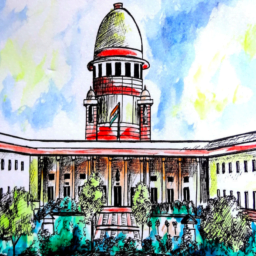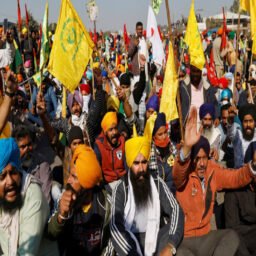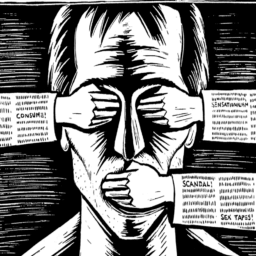
“The judiciary was to be an arm of social revolution upholding the equality that Indians had longed for.”(1)
BEFORE 99th CONSTITUTIONAL AMENDMENT
The Appointment of Judges: According to Article-124 of the constitution the Chief Justice of India (CJI) of India was appointed by the President of India with the consultation of Judges of The Supreme Court or Judges of The High Court or The Chief Justice of India (in case of appointment of other Chief justice), as he deemed necessary for the purpose. But while appointing the other Judges, the president may consult with the Chief Justice of India. Under Article 124 clause 2, it was clearly specified that in the appointment of other Judges of The Supreme Court the President is bound to consult with the Chief Justice of India and for the appointment of The Chief Justice of India he was not bound to consult with anyone. The word ‘may consult used under Article 124 Clause 2 clarified that President is not bound by any consultation; hence he didn’t need to consult with anyone.
Till 1973, the Collegium System was followed, where the Senior-most Judge of The Supreme Court was appointed as the Chief Justice of India (CJI). This practice was being followed unconditionally. In 1956, the Law Commission headed by the then-Attorney General M. C. Setalvaddisagreed with this system of appointment of judges on a seniority basis. He said that a Judge shall be appointed based on experience, merit, and administrative competence; seniority cannot be the sole factor. On 25th April 1973the government snapped this practice and Justice A.N. Ray was appointed as the Chief Justice of India by superseding J. Sętal, J. Hedge, and J. Grover, even though they were the senior judges for that time. Later they resign from their post and this leads to severe criticism by the Bar and the public.
To support this drastic change made by the government, they make few arguments to support their actions:
- The statement was made by Attorney General M.C. Setalvad in 1956.
- According to Article 124(2) President ‘may’ consult doesn’t mean that the President is bound by the consultation on CJI and the High Court judges.
- The government also pleads that the philosophy of Judges must be considered. According to the government, the philosophy of the Court must accord to the constitution to work co-jointly.
Then in 1977, under theUnion of India vs Sankalchand Seth (2), the meaning of the word ‘consultation’ under Article 124(2) was explained. Consultation means “Full and Effective consultation but the President is not bound by the Consultation” This judgment doesn’t support the collegium system of appointment of judges.
Then in 1982 the Supreme Court confirmed the judgment of the Sankalchand Sethjudgment and held that the President is not bound by any consultation, this was held in S.P. Gupta vs Union of India, 1982(3)popularly known as Judges Transfer Case I. This reflects that the executive has the ultimate power to appoint the Judges.
JUDGES TRANSFER CASE II
The Supreme Court Advocates on Record Association vs Union Of India, 1993 (4)
Here, a nine Judges bench was constituted and by 7:2 the majority overruled the judgment made in Judges Transfer case I and held that the President is bound by the consultation. He cannot appoint any person according to his discretion; the appointment of judges was taken away by the executive and the central government had no power in this matter.
The important guidelines made by the court were:
- The recommendation of CJI will be final for such an appointment, but he must consult with two Senior-most judges.
- In the appointment’s case of Judges of The High Court, the consultation given by the CJI will be Final.
- In case of transfer of judges of The High Court, the consultation given by the CJI will be final.
- Transfer of Chief Justice and Judges of The High Court cannot be challenged in Court.
- CJI will be appointed on a seniority basis.
- No judges can be appointed by the Union The government without consultation of CJI.
- Fixation of the strength in The High Court was justifiable.
JUDGES TRANSFER CASE III
In re Presidential Reference (5), a nine Judges bench of The Supreme Court was established and they unanimously held that the recommendation made by the Chief Justice of India (CJI) on the appointment of Judges of The Supreme Court and the High Court without following the consultation process is not binding on the government.
The important guidelines made by the court in this case were:
- If the CJI consulting with two Senior-most judges, recommend the President, then the appointment will not be binding on the government.
- The majority of judges held that the CJI must consult four Senior-most Judges of The Supreme Court.
- In these four Senior-most Judges, one shall be the successor of CJI.
- If any two Judges gave an adverse opinion, the CJI should not send the recommendation to the government.
- In case of appointment of Judges of The High Court, the CJI may consult with two Senior-most Judges only.
- In case of transfer of Judges of The High Court, the CJI may consult with two Chief Justices of The High Court (between whom the transfer has to be made).
But after this according to the government, there was no transparency in the appointment of Judges, and to resolve this they brought the 99th Constitutional Amendment Act, 2014 and made a commission for the appointment of Judges. The Commission was known as National Judicial Appointment Commission. The 99th Constitutional Amendment amended Article 124(2), 127, and 128. It inserted Article 124A, 124B, and 124C. According to this amendment, every Judge of The Supreme Court shall be appointed by the President by warrant under his hand and seal on the recommendation of the National Judicial Appointment Commission referred under Article 124A. After this amendment, there was no need for consultation by the President with the Judges of The Supreme Court and The High Courts.
STRUCTURE OF NJAC (6)
- The Chief Justice of India, Chairperson, ex officio
- Two other Senior-most Judges of The Supreme Court
- The Union Minister in charge of Law and Justice
- Two eminent persons nominated by the committee comprising CJI, Prime Minister, and leader of the opposition. Provided that one eminent person shall belong to the SC, ST, OBC, minorities, or women category. Provided further that an eminent person shall be nominated for the period of 3 years and shall not be eligible for renomination.
In this commission, three-members were of the judiciary and three of the executive. A definite interference of the executive into the judicial matter was seen.
JUDGES TRANSFER CASE IV
Then in 2015 in the historic judgment of The Supreme Court Advocates-on-Record Association vs Union of India (7) (also known as Judges Transfer Case IV), the Supreme Court of India by its order declared Constitution (Ninety-ninth) Amendment Act, 2014 and National Judicial Appointment Commission Act, 2014 Unconstitutional and Void. The system of appointment of Judges of The Supreme Court and The High Courts and the transfer of Judges of The High Courts before the 99th Constitutional Amendment (the Collegium System) to be Operative.
Author(s) Name: Ritika Saxena (Shri Ramswaroop Memorial University, Lucknow)
Reference(s):
- http://www.legalservicesindia.com/article/133/Need-for-National-Judicial-Commission.html#:~:text=had%20longed%20for%E2%80%9D.-,In%20India%20from%20times%20immemorial%20Judges%20have%20been%20held%20in,and%20revered%20as%20super%20humans.
- AIR 1977 SC 2328.
- AIR 1982 SC 149.
- (1993) 4SCC 441.
- AIR 1999 SC 1.
- Dr, J. N. Pandey, Constitutional Law of India, Central Law Agency (55th Edition, page no. 533.
- (2015) AIR SCW 5457.















